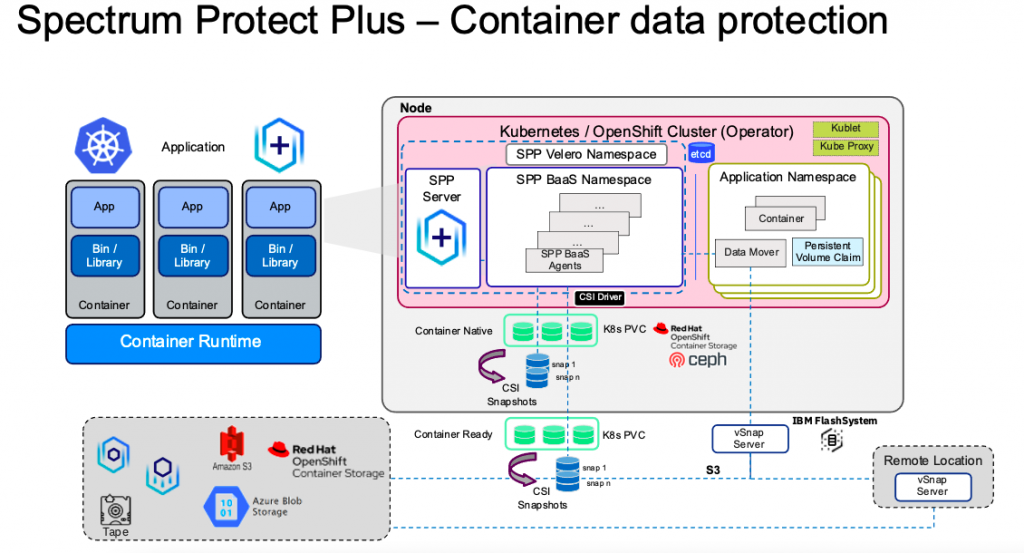.
Supercharge Container Data Resilience and Protection With IBM Spectrum Protect Plus
July 8, 2021 | Written by: Harishankar Singh
Categorized: . | IT infrastructure
Share this post:
New age enterprise IT organizations are adopting new technology trends in the marketplace. Containerization of application is one such technology pillar that is driving this digital transformation journey.
Higher data volumes, complex architectures, and siloed underlying infrastructures are increasing IT budgets and manageability challenges. As per the recent survey statistics, IDC forecasts, “By 2022, 35% of production apps will be cloud-native or containerized – utilizing microservices, containers, and dynamic orchestration”.
In almost every analyst feedback polls, customers highlighted, “Persistent storage and metadata backup and recovery” as the biggest factor influencing container adoption.
Kubernetes, Red Hat OpenShift and Data Services
OpenShift is an enterprise-grade container orchestration software product developed by Red Hat. It is built on top of open-source Kubernetes and Docker distributions. OpenShift highlights 5 pillars for data services as a foundation including – efficiency, discovery, governance, security, resiliency, and protection.
A typical conversation for resiliency and protection starts by assessing – intolerance to outage and business impact. These two questions lead to defining and achieving stringent data availability and recovery SLAs.

What is IBM Spectrum Protect Plus?
IBM Spectrum Protect Plus is the Modern Data Resilience and Protection solution for Red Hat OpenShift and Kubernetes environments. Spectrum Protect Plus also provides – backup, recovery, replication, and reuse for VMs, databases, applications, file systems, SaaS workloads, containers, and cloud environments.
Spectrum Protect Plus can be deployed – as a virtual appliance, container application and public cloud hosted instance. The diagram shows how Spectrum Protect Plus can be deployed to address multiple use-cases from a single workflow.

How Spectrum Protect Plus addresses OpenShift Data Resilience challenges?
IBM Spectrum Protect Plus supports – data recovery, disaster recovery, cyber resilience, corporate governance, and compliance use-cases for Red Hat OpenShift Container Platforms. It also caters to other modern and rich data re-use cases – DevOps, Test/Dev, analytics, and reporting.
IBM Spectrum Protect Plus protects Red Hat OpenShift environments with an integrated approach that starts with the ability to deploy IBM Spectrum Protect Plus Server as a container using a Red Hat OpenShift (Kubernetes) operator.
Container Storage Interface (CSI) Snapshots – Data
In Kubernetes world, the data for “stateful” applications can reside on either a container-ready or container-native storage. A persistent volume claim (PVC) is a request made for storage by the user or application.
Spectrum Protect Plus takes point-in-time snapshot copies of these Kubernetes PVCs using Container Storage Interface (CSI) drivers. These CSI snapshots can later be used for data re-use cases including – DevOps, Test/Dev, analytics, and reporting. Giving administrators and app developers the choice to rapidly rollback to previous versions within the shortest recovery SLAs (RPOs & RTOs).
OpenShift APIs for Data Protection (OADP) – Application, namespace, and cluster metadata.
OADP is an operator that creates a backup and restores APIs in Red Hat OpenShift clusters. Spectrum Protect Plus uses OADP to backup and restore OpenShift cluster resources – YAML config files, internal images, and persistent volume data. Using OADP, IBM Spectrum Protect Plus can back up an entire container-based application, including all its resources, metadata (etcd), and PVs. This backup can be used to build application clones on other OpenShift clusters for disaster recovery or dev/test and analytics purposes.
Data Replication and Long-term Retention
The backup data is copied to a storage repository called vSnap Server. This component is sitting outside of OpenShift/Kubernetes cluster. The primary vSnap pool can be replicated to a remote vSnap server. It can also be moved to either physical tape, on-premises Object Storage, and leading Public Cloud Storage services for long-term archival and retention.
The diagram below shows the overall architecture of how Spectrum Protect Plus provides data resilience in a Red Hat OpenShift/Kubernetes container environment. This covers all the use-cases including – backup, restore, disaster recovery, reuse, replication, archival, and long-term retention.

Why Spectrum Protect Plus for Containers?
IBM Spectrum Protect Plus has the first mover advantage backed by key business value-propositions. Let us look at some of the key business value propositions:
- Total Cost of Ownership (TCO)
IBM Spectrum Protect Plus is a complete software-defined storage solution. There is no expensive purpose-built hardware appliance to maintain or licenses to procure. It offers a simple CapEx/OpEx/Hybrid and pay-as-you-grow licensing model that helps save 52% cost over a 3-year period.
Spectrum Protect Plus is easy to acquire and is simple to deploy which helps produce an immediate return-on-investment (ROI).
2. Management Simplicity:
IBM Spectrum Protect Plus follows a simple unified user experience strategy. The user interface offers customizable widgets, dashboards, and role-based access controls. Users can easily view Kubernetes inventory via kubectl Command Line Interface (CLI) or Spectrum Protect Plus Graphical User Interface (GUI).

3. Global Search & Rapid Recovery:
Spectrum Protect Plus does Google like indexing and search. It also provides best-in-class instant access to backup data for both operational recovery and data reuse.
4. Extensive Workload Coverage:
IBM Spectrum Protect Plus provides automated, centrally scheduled, policy-managed backup capabilities for multiple workloads. These include VMs, databases, applications, file systems, SaaS, and container workloads.

5. Maximize Operational Efficiency:
IBM Spectrum Protect Plus is an end-to-end, modern data protection solution that unifies data recovery, data retention, and data reuse for physical, virtualized, and container-based workloads. Data can be copied to secondary sites, Cloud Object Storage, or IBM Spectrum Protect for secure long-term archival and retention.
IBM Spectrum Protect Plus can be deployed on-premises, in a cloud-native containerized environment and as a Public Cloud instance, supporting flexible Hybrid IT deployment choices.
Conclusion
The unique combination of IBM Spectrum Protect Plus and Red Hat OpenShift/Kubernetes provides powerful yet simple data resilience and protection solutions for cloud-native applications. Evaluate IBM Spectrum Protect Plus with a free 30-day trial to realize the value and benefits listed here.
Connect with Harishankar Singh LinkedIn
References
Start exploring and learn more about IBM Spectrum Protect Plus for Red Hat OpenShift/Kubernetes.

SME - Tech Sales for IBM SDS, MDP & Hybrid Cloud
Insurance Company Brings Predictability into Sales Processes with AI
Generally speaking, sales drives everything else in the business – so, it's a no-brainer that the ability to accurately predict sales is very important for any business. It helps companies better predict and plan for demand throughout the year and enables executives to make wiser business decisions.
Never miss an incident with an application-centric AIOps platform
Applications are bound to face occasional outages and performance issues, making the job of IT Ops all the more critical. Here is where AIOps simplifies the resolution of issues, even proactively, before it leads to a loss in revenue or customers.
How ICICI Prudential Life Insurance is Scaling Customer Care and Leveraging AI to Personalize Experiences
Organisations are constantly challenged to meet dynamic customer requirements and rethink ways to engage with them on their terms and as per their convenience. With customers at the core of decision making and business success, organisations are tuning to digital capabilities that can support new-age services. When done well, after sales service boosts the overall customer experience by providing […]


